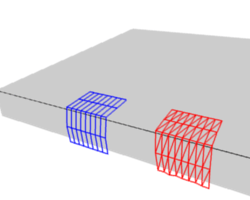Внутрішньо – Interior¶
In between each neighboring vertex of a mesh, you typically create edges to connect them. Imagine each edge as a spring. Any mechanical spring is able to stretch under tension, and to squeeze under pressure. All springs have an ideal length, and a stiffness that limits how far you can stretch or squeeze the spring.
In Blender’s case, the ideal length is the original edge length which you designed as a part of your mesh, even before you enable the Soft Body system. Until you add the Soft Body physics, all springs are assumed to be perfectly stiff: no stretch and no squeeze.
You can adjust the stiffness of all those edge springs, allowing your mesh to sag, to bend, to flutter in the breeze, or to puddle up on the ground.
To create a connection between the vertices of a soft body object there have to be forces that hold the vertices together. These forces are effective along the edges in a mesh, the connections between the vertices. The forces act like a spring. Fig. Вершини та сили уздовж їх з’єднувальних ребер. illustrates how a 3×3 grid of vertices (a mesh plane in Blender) are connected in a soft body simulation.
But two vertices could freely rotate if you do not create additional edges between them. The logical method to keep a body from collapsing would be to create additional edges between the vertices. This works pretty well, but would change your mesh topology drastically.
Luckily, Blender allows to define additional virtual connections. On one hand you can define virtual connections between the diagonal edges of a quad face (Stiff Quads Fig. Додаткові сили з увімкненою опцією Stiff Quads.), on the other hand you can define virtual connections between a vertex and any vertices connected to its neighbors“ Bending Stiffness. In other words, the amount of bend that is allowed between a vertex and any other vertex that is separated by two edge connections.
Settings¶
The characteristics of edges are set with the Springs and Stiff Quads properties in the Soft Body Edges panel. See the Soft Body Edges settings for details.
Tips: Preventing Collapse¶
Тугість 4-бічників – Stiff Quads¶
To show the effect of the different edge settings we will use two cubes (blue: only quads, red: only tris) and let them fall without any goal onto a plane (how to set up collision is shown on the page Collisions). See the example blend-file.
На Ілюстрації Без Stiff Quads – Stiff Quads.. використовуються стандартні устави (без Stiff Quads). Куб «лише з 4-бічників» буде згортатися повністю, а куб з 3-бічників збереже свою форму, хоча він деформується тимчасово через сили, що створюються у ході зіткнення.
На Ілюстрації Із Stiff Quads – Stiff Quads. Stiff Quads активовано (для обох кубів). Обидва куби зберігають свою форму, тут немає відмінності для червоного куба, оскільки він взагалі немає 4-бічників.
Тугість Згинання – Bending Stiffness¶
Другий метод зупинити об’єкт від згортання – це змінити його параметр тугості згинання Bending. Це включає діагональні ребра (згасання також застосовується до цих з’єднань).
На Ілюстрації Bending Stiffness. активовано Bending з уставою сили як 1. Тепер два куби більш жорсткі.
Тугість згинання може також вживатися, якщо ви хочете зробити підподілену площину подібною на дошку. Без Bending грані можуть вільно обертатися одна перед одною, як шарніри, Ілюстрація No bending stiffness.. Там не буде жодних змін в імітації, якщо ви активували Stiff Quads, оскільки грані не деформуються взагалі у цьому прикладі.
Тугість згинання є силою, необхідною для деформування площини.









